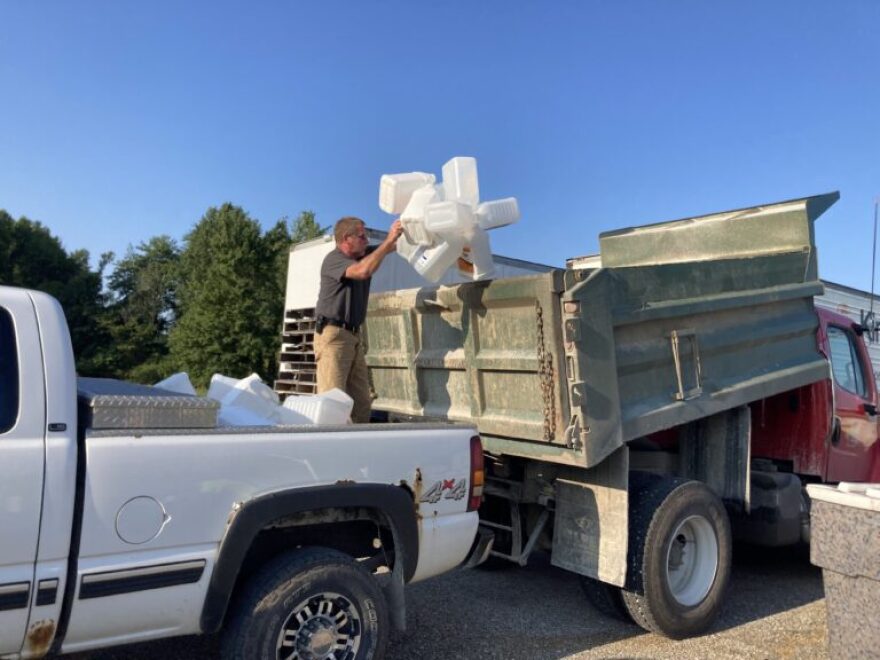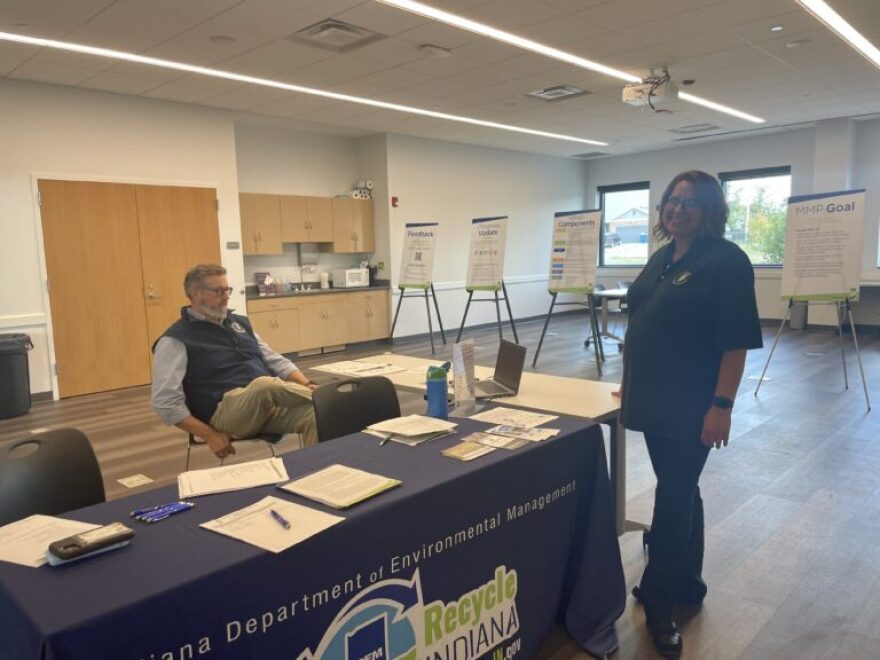Indiana is finalizing a new vision to manage Hoosier waste — from food, construction, technology, textiles and more — and boost the economy.
The project, spearheaded by the Indiana Department of Environmental Management and British contractor Eunomia, will replace a 20-year plan that has been in force for more than three decades.
That plan “was centered on disposal and basic waste handling,” IDEM Commissioner Clint Woods said in a late August news release. “Today, we need a forward-looking plan that reflects 35 years of innovation, shifting markets, and evolving environmental priorities. … Building a circular economy can strengthen Indiana’s economic future.”
IDEM won about $600,000 from the U.S. Environmental Protection Agency for the updates, according to the transcript of a 2023 meeting.
The plan may consider recycling requirements, commercial food waste diversion requirements and a per-ton surcharge on landfilled or incinerated waste, according to a late July meeting. That’s alongside the infrastructure investments, public education and more intended to advance the state’s goal of recycling 50% of its waste.
The final product is expected by the end of 2025. It will “act as a blueprint” for the state, solid waste management districts, industry and more, IDEM spokesman Barry Sneed said.

Local units of government can use the resulting guidelines, templates and pass-through dollars to revisit their own antiquated plans. IDEM also hopes to uplift recyclers and manufacturers using recycled goods.
“You know, 1991 was the last (plan). Think about all that’s changed,” Natalie Rodriguez, an agency spokeswoman, said at September open house. “Think about all the electronics that are now in the waste stream, and the fact that we can recycle some of that as well … It’s a commodity!”
Landfill gates lead to a lofty goal
Indiana made its first foray into solid waste regulations in 1953, when the General Assembly authorized county commissioners to establish dumps and adopt garbage-related ordinances “for the protection of public health.”
Some were burn dumps. Lawmakers enacted an air pollution law in 1961, according to an IDEM history, but federal Clean Air Act amendments four years later spurred more changes. The state banned the open burning of waste in 1969, the same year cities and towns gained the power to manage their own waste facilities.
Indiana didn’t issue its first modern landfill permit until 1974, per IDEM, or its first waste management plan until 1980. The latter was a prerequisite for continued EPA funding.
That year, Indiana had about 150 permitted landfills. Almost half of them had filled up and closed down within a decade, leaving 79 in 1990.
“Gates continue to lock on landfills … Yet we still throw away tons of recyclable materials every single day,” then-Gov. Evan Bayh wrote in the introduction to the 1991 plan, which sought to “avert a garbage crisis.”
It was one result of a sweeping law that mandated county solid waste management districts and set a 50% recycling goal for 2001.
But two decades past that deadline, the state is recycling somewhere between 9% and 15% of waste — and has just 34 landfills open, according to contractor Eunomia and a 2021 IDEM study. Districts are optional, too.

Those remaining “keep pretty attuned” to IDEM’s activities, said Carla Striegel-Winner, who leads the Dubois County Solid Waste Management District and is on the board for the Association of Indiana Solid Waste Management Districts. They go to the agency for grants, technical expertise and more — but “currently, that plan is not something that we would even think about on a day-to-day basis.”
“With it being a new plan, that could easily change,” Striegel-Winner said.
“I see it being more the big picture,” she continued, and “as being sort of the glue that could kind of pull us together.”
Contractor’s strategy
Eunomia’s contract — worth up to $300,000 — began last October and lasts a year. At July’s online meeting, the consultant unveiled a short list of proposals that could help Indiana reach that 50% goal:
- Requiring commercial food waste generators like grocery stores or restaurants to divert the surplus from landfill to alternatives like composting or donation.
- Investing in sorting and processing infrastructure to increase facility capacity or improve how much material they can recover.
- Investing in collection pathways, like adding drop-off sites and curbside recycling options, or hosting community collection events.
- Educating Hoosiers on recycling practices and to raise awareness.
- Requiring that Hoosiers separate recyclable materials from trash.
- Setting interim targets for the state as it works toward the 50% goal.
- Adding a per-ton surcharge to landfilled or incinerated waste.
IDEM’s Sneed noted the plan will “provide data and insight to help inform decisions” but said that any recommendations for new legislation, regulations or actions — including fees — would “be up to the appropriate rule-making bodies.”
The proposals were developed methodically.
Contractors gathered data and conducted research on Indiana’s waste management systems to create a “baseline” model of the status quo and a “business-as-usual” view of the future.
They focused on the methods and materials that would make the biggest difference. Indiana’s economy is losing out on more than $400 million annually when valuable materials like metal, plastic, paper and more are trashed instead of recovered, according to the presentation.
“By prioritizing these materials for the model, we can focus on where we can feasibly have the greatest potential impact,” Project Coordinator Iris Liu said.

The consultants also conducted surveys and interviews with stakeholders, like solid waste management districts and recyclers. IDEM staff held open houses around the state to hear from more.
They compiled a long list of ideas, then narrowed them down using a scoring sheet — with considerations like implementation costs and stakeholder pushback — and IDEM’s input.
The next step was to model the impacts of those proposals. Last is collecting it all in the state’s new plan.
Help wanted
In Dubois County, Striegel-Winner’s team is “super small.” Even as director, she does everything from answering the phones to doing payroll and even working at the site.
The county of 47,000 residents is largely rural. One processing center takes old paint, household chemicals, electronics and bulky waste. Recycling is done at eight drop-off sites for free, while trash incurs a fee.
But the logistics are challenging.
“We have a limit to the type of recycling that we can take. Those limits aren’t because that can’t be — in some way, shape or form — recycled,” Striegel-Winner said. “Those limits are because it’s not feasible to try and get that from point A to point B, where somebody would want to purchase that and … turn it into something new.”
The county can take glass, unlike others in southern Indiana. Clear and colorful glass must be separated, then stored until there’s enough to transport for recycling. Only plastics labeled 1 and 2 are accepted — also manually sorted, because there’s no specialized sorting facility nearby.
“People have to choose to do that sorting, and so we probably get a little less than if you just had a curbside bin out,” Striegel-Winner noted.
She’s interested in the prospect of sorting and processing aid.

“We do not have access to a lot of that infrastructure,” she said. “We need businesses that will set up in our area, and be able to make money from sorting our stuff. … All of that is going to be a huge improvement.”
Public education is also key.
“There’s still tons of stuff going into landfill that shouldn’t,” Striegel-Winner said. “I feel like we’ve become more of a throwaway society.”
“We get people thanking us all the time for … the time that we take with them to help them understand. They don’t know about us until they need us — and when they need us, we’re here,” she later added. “We’re here with those answers. We’re here with those recycling and disposal options.”
For others, food waste is the next frontier.
It represents a whopping 40% of the waste stream at Indiana University’s Bloomington campus, for instance. That’s according to Chief Sustainability Officer Jessica Davis, whose team advises all of IU’s campuses.
“It’s a pretty significant hit if we aren’t able to recover that, which is why we’re focused on solutions,” she said.
The Bloomington and Indianapolis locations had “pretty robust” composting programs pre-pandemic. Amid the chaos, many companies serving big institutions like IU stopped offering those services or even went out of business, per Davis.
“So, really, how can we extract the highest value out of this material ourselves?” she said. Bringing composting in-house “also kind of mitigates that risk of being overly reliant on external vendors.”
IU is piloting a food waste dehydrator purchased through a state grant. Removing the water makes it lighter and more compact, and therefore cheaper to dispose of, Davis described.
But the university is interested in using it — like for soil or biofuel. It’s already submitted another grant application to buy an in-vessel composter to speed up the decomposition.
Those efforts come in addition to a wide variety of existing programs, many of which bring financial perks alongside environmental ones.
The university’s used but serviceable items are sold back to campus, so that employees, students and community members can “go shopping” among the surplus. Huge amounts of stuff are collected from on-campus housing during the springtime move-out, and are collected for free reuse or paid surplus instead of becoming “a really big trash bill.” Recycling contracts at some campuses include a per-ton rebate, too.
Others programs are for the “mission,” Davis said, like “fix-it clinics” or free bicycle repair services in the fall and spring.
“Any skills that we can equip (students) with, even if it’s maybe an outside-of-the-classroom skill, is of value,” she continued. “… Students might have financial struggles, so if they can repair something for free or very, very cheaply, it might be just one less stressor in their life.”
The plan is also expected to include a focus on preventing waste.

“If we’re not doing something about the waste that we currently have, we’re drowning in waste,” Purdue University Professor John Sutherland said. “But, you know, if we’re trying to be smart, we should be able to walk and chew gum at the same time. … We should be taking efforts to … reduce the amount that we’re generating in the first place.”
Sutherland leads the institution’s Laboratory for Sustainable Manufacturing and environmental engineering program. He’s a fan of “lean” manufacturing that cuts out unnecessary materials, motions and more in pursuit of efficiency.
“If I wait until I have waste, it’s going to cost me,” he said. “… By being smarter about the system that you create, not only do you reduce what you have to pay at the back end (for disposal) but you’ve undoubtedly saved money by using less resources.”
Government action can make unwanted behaviors more expensive. But Sutherland was confident the incentives go deeper.
“I was doing this before the regulations were there,” he said. “I was helping companies get better without (those).”
Decades ago, Sutherland helped Ford Motors eliminate expensive and dangerous metal-working fluids — along with related procurement and health costs. The move also meant less environmental remediation.
Now, his lab is working to make it easier to recycle rare earth elements, among other projects. They’re used technology from smartphones and wind turbines to medical and defense systems.
“It’s an energy security issue, right? We’re too reliant on non-domestic sources for these materials that are vital to the economy,” Sutherland said. “To me, you know, recycling and remanufacturing of the stuff that we already have here — it just makes sense.”
Indiana Capital Chronicle is part of States Newsroom, a nonprofit news network supported by grants and a coalition of donors as a 501c(3) public charity. Indiana Capital Chronicle maintains editorial independence. Contact Editor Niki Kelly for questions: info@indianacapitalchronicle.com.




